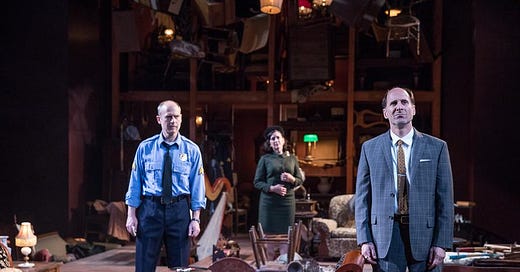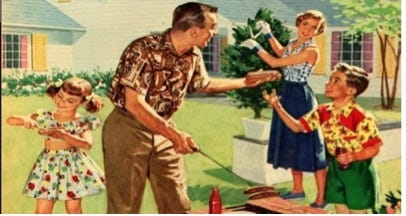My childhood outdoor fun is associated with my dad’s 1968 green VW Van. It was his crew bus that he drove to his small publishing house on weekdays, but on the weekends, my younger brother and I would coax him into driving us on the green Van to the suburb. Believe it or not, I was more excited about using the different doors of dad’s Van to get in and out with his German Shepherd Fiddle and washing the Van with Dad than setting up the barbecue with Mom and Grandma or collecting fire wood with Grandpa or beating my brother in frisbee throws.
Now I drive a VW Atlas. Dad and Grannies passed. Fiddle passed. I am thousands of miles away from Mom. My brother kept the frisbee disk in his antique collections, and my dad’s green VW Van is on my toy cars shelf.
Any term that would best express the essence of the past family concept works well for my purpose. But I’d opt for “atomic” to refer to what many people at my age miss these days- the atomic family.
With respect to Brooks and like-minded people who argue that “it’s time to figure out better ways to live together,” I believe the wide-scope idea of ‘better ways’ evokes different or even opposite values. I do not side with either the traditional or the modern family structures. Rather, I’d like to share my observation of the families in the near past and the present.
The atomic family which started to decline from the late 20th century changed to a variety of family structures such as single-parent, same-sex parents, or common law partners, not to mention single people living with their pets. Add to this, the divorced parents and re-married parent family structures and polygamous families- a form of family life in which a man legally marries more than one wife and makes multiple families. I’ve met such families during my expat life in some Moslem countries. You see two to four atomic families conglomerate at the center- the Father.
The theme of Family has appeared in thousands of novels, cartoons, films, plays and other forms of art that more or less depict images of family matters in real life. Love, death, loss, greed, cheating, regret, jealousy, sacrifice, financial issues and the like are among the most frequent sub-themes to name just a few. For my argument, I take Arthur Miller’s The Price (1967) and Tracy Letts’ Killer Joe (1991) as instances of non-atomic families. Both plays center around financial issues within different family structures that, in contrast to the nuclear families like in The Grapes of Wrath, come short of familial support for individual members. In his novel, Beck narrates how self-centeredness and emphasis on “I” shifts to “We” while the family goes through hardships, unsuccessful job hunting and disappointments during the Great Depression.
Miller’s life was also affected by the Great Depression. His father went bankrupt during the Depression and the financial insecurity in the modern life became one of the major themes in his plays. When Miller wrote Death of a Salesman, the atomic family structure was still dominant in the 1940s. The play portrays Willy Loman’s identity problem and his inability to face and accept changes in the society and within himself. His sons try their best to disillusion him, but the old man dies and is buried with his fantasies about a successful business.
The Price also shows the financial concerns of a (disintegrated) family, but with a different portrayal of the father figure that, contrary to Willy Loman, never appears on the stage, but his death is the key to the conflict. After years of estrangement, two brothers meet each other to sell their deceased father’s furniture.
Miller’s preoccupation with financial issues is portrayed in Victor, the younger brother who quit college to work and take care of his jobless father during the Great Depression. The play gets tense when his elder brother Walter, a successful surgeon, reveals that their father did have enough money to let Victor finish college but hid his savings for investment and personal profit.
Although The Price is based in a family structure different from the atomic one in Death of a Salesman, Victor’s sacrifice for his jobless father and Walter’s care for Victor still emphasize family attachment. The deceased father had hidden his several thousand dollars from Victor who did away with his wishes and ambitions, but money doesn’t completely degrade familial affection.
An extreme case of a disintegrated family is depicted in Killer Joe. Chris is a young drug dealer who hires Joe Cooper, a contract killer, to kill his mother so the family can gain control over the mother’s life insurance policy that would legally belong to Dottie, his younger sister.
His father Ansel and the stepmother are accessories to the crime. But at the end, the family realizes that the mother’s boyfriend, not Dottie, is entitled to her life insurance money.
Let’s loop back on The Price and the significance of the title that can be extended to Killer Joe. The characters in these plays, and in Death of a Salesman for that matter, have taken costly decisions. The decisions get costlier from the mid 20th century to the late 20th century. Willy Loman in the late 1940s gets stuck in his fancy world and resists change notwithstanding the family’s efforts to save him against his fatal illusions. Moving along the history line, we reach Victor in the late 1960s, in a less integrated family, who decided to sacrifice his ambitions and save the family as the bread winner. He lived 30 years with the fabricated truth about his father’s empty pocket while the old man was sleeping on thousands of dollars. And we see The Smiths’ shattered family in Killer Joe in early ‘90s with a deadly- rather than costly- decision as the last alternative to settle financial crisis. The father figure? You don’t want to know: divorced and remarried, selfish, greedy, indolent, and TV addict. To be precise, Ansel Smith! The father is anything but the magnetic core. The stepmother? You don’t want to know this either. Sharla plays dirty here. She and Chris’s mother’s boyfriend have plotted all this.
In fact, Chris’s malice is not in favor of a crashed entity called ‘family.’ He has to pay his debts to the drug dealers and his divorced mother’s insurance money is all he could think of. Chris doesn’t mind his young sister being a retainer fee to Joe Cooper, the killer. In Killer Joe, it’s just the money that matters.
The Price, on the other hand, sheds light on the regret over the lost values that would hardly be regained at any price. Money can’t compensate for the emotional and financial losses, but the family still matters. After 30 years, Walter wants the familial attachment back and offers help to his younger brother Victor, but he declines the offer.
What is the price of our futuristic family structure? The price of losing the atomic family?
Please like the post if you found it interesting. Writers need support from one other and a sustained relation with their readers. Subscribe to Backstage on foroz.substack.com.







Nostalgic. I was wondering what a futuristic family concept would be. Presently, I can't think of anything but lonely robumans (robot-humans) in a lonesome space.